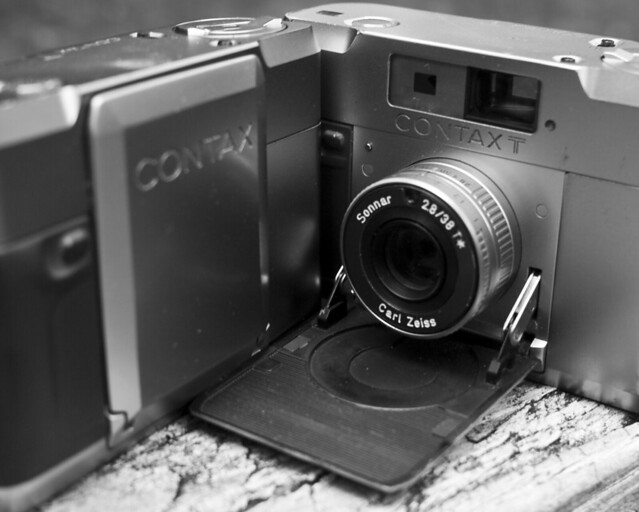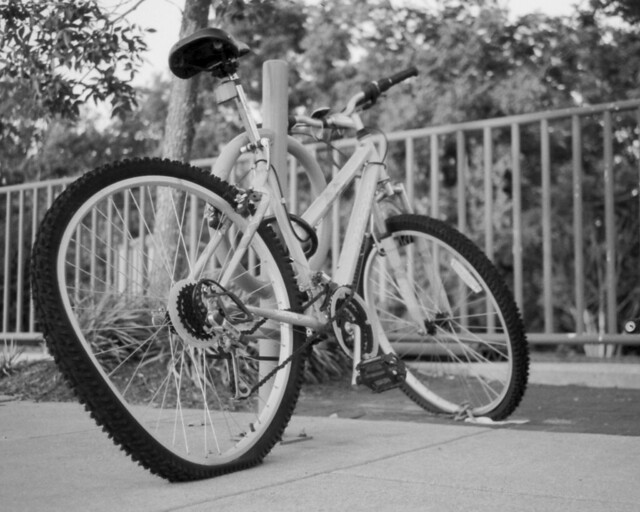Is that a rangefinder in your pocket, or..? (the Contax T)

two contax t rangefinders. (click any photo to view on flickr).
This is probably the third article I’ve written about the Contax T, and hopefully the last. I scrapped the others because they simply didn’t live up to the camera. I wrote one article comparing the T to an Olympus XA. This makes a lot of sense to me – both are aperture-priority (only) manual focus rangefinders with nearly identical compact dimensions. But this article was unfair – I own two Ts and zero XAs. I have used an XA, and have pretty clear memories of the things I didn’t love about it, but until I buy another one for the purpose of comparing to the T, I don’t think it’s quite right to base an article upon said comparison. I do plan to do this, however, as the T seems very strongly influenced by the XA, so I guess my earlier statement that this will be my last article on the T was a lie.
In truth, though, it would also be unfair to the T to lead with an article pitting it against another. The T doesn’t solely exist as an alternative to the XA, the T stands strong on its own. These days I’ll carry any number of rangefinders with me into DC, but I have to consider how much pedestrian traffic I’ll be subject to (or, how sardine-like the Metro will be), how much bulk a given camera will add to me, and how sturdy said camera is, just in case. On days when I don’t want to deal with this decision, or nothing seems like a great idea, the Contax T comes with me. More often than not these days, unless I really feel like shooting something else, or I have something specific in mind for medium format, the T is the camera I want by my side anyway. This is largely due to its lilliputian yet sturdy nature. I can keep it in a small pocket in my messenger bag (rather than strapped separately around my neck), not notice a major weight increase, and trust that it’s not constantly on the brink of being crushed.

a diptych showing some decent separation via depth-of-field with the 38/2.8
Of course, aside from being sturdy and small, a camera needs to be good at taking pictures. And it needs to be good at working with its operator, which of course means something different to everyone. For me, the T works out quite well on both counts. The lens, a five-element 38/2.8 Zeiss Sonnar T*, is a stunning chunk of glass in a small barrel. Of course lenses are more than just their optics, and this is where things get a bit more interesting. The focus feel is amazing, better than most larger lenses I’ve used, and the best I’ve ever felt in something so compact. Unfortunately, there is no focus tab, so you are stuck handling a very tiny ring. Focusing is tricky in a package this small, as blocking the rangefinder in the process is pretty much inevitable. Compounded with the tiny aperture ring inexplicably stuffed behind the focus ring, and the lens is not really the most ergonomic thing to use.
This is an important point to note, because the camera is manual focus only, and aperture priority only. The user will be spending a lot of time with these rings. If you want to blow it all to the wind and rely on hyperfocal, this is indicated with f/8 in green on the aperture ring, and a green dot and DOF scale on the focus ring corresponding to hyperfocal at f/8. Aside from these controls, the user is granted a +1.5 EV exposure compensation button on the top deck, as well as a self-timer switch, and of course the shutter release. The release itself is an unnecessary touch for the luxury market – a synthetic ruby designed by Kyocera’s Advanced Ceramics division. As this was Kyocera’s first creation under the Contax name, it’s understandable that they wanted to go all out. Understandable, but still a bit humorous. Anyway, the ergonomics of the camera are not the best, even for my tiny pixie hands. I can’t even begin to imagine the sort of person who likes to slap gigantic battery grips on their already massive SLRs handling one of these petite cameras.

out of focus areas get a little bit edgy at times, but images are crisp.
The aforementioned +1.5 EV compensation button is the only real control over exposure that a T user gets. However, the T does not (thankfully) rely on DX codes to set the meter ISO, so as long as you’re mindful of what you’re doing, you can adjust ISO for whatever compensation you need. ISO readout is on the back of the camera, adjusted by pressing a button on the back and rotating the outer ring of the rewind knob. Metering is not TTL, but rather via a sensor on the front of the lens, immediately above the front element. The lens is not threaded for filters, but if one was to find slip-on filters that would fit, they would (thankfully) be over the meter sensor as well. Using common sense to compensate for backlighting via the +1.5 EV button, and otherwise trusting the meter has yet to let me down. The camera will warn you with an over light if you’re working outside the range of capable shutter speeds, but thankfully it will not prevent you from shooting it anyway. An overexposed shot is, after all, better than missing the decisive moment. There is no AE lock, which is a bit of a let-down.
I mentioned the overexposure light, one of four LEDs inside the finder to give you an idea of the shutter speed. The shutter ranges from 1/500″ down to 8″, with indicators for ’1/500″ – 1/125″,’ ’1/125″ – 1/30″,’ and ’1/30″ – 8″.’ You never know exactly what it’s doing, but you get a sense, and can judge whether you’re in hold-your-breath or I-really-need-a-tripod territory. The finder is bright, has good eye relief, though is a bit small and only ~.75x. The rangefinder spot is a yellow diamond, a nice throwback to Yashicas past. No parallax compensation is provided, not even a frame indicator. No aperture readout, but the aperture adjustment happens in even clicks of full stops, and can thus be adjusted blindly with ease.

the t’s compact size means i always have a camera with me in the district.
Loading the camera is a bit of a trick. Release a latch on the bottom of the camera very carefully (this latch is a common point of failure) The entire back and bottom plate are a single shell which is removed, much like on a Leica CL. Also like on the CL, once opened, there is a swing-down pressure plate on the body side of things. Unfold this, and open up the camera (not doing so reportedly can strip some gears). Get the leader into the takeup, make sure the sprockets are engaged, shut the pressure plate, and wind on a bit. Make sure advancing is smooth, make absolutely sure the sprockets are (still) engaged, and that everything is tight. Frame tolerances are incredibly tight on this camera, and if loading isn’t spot on, overlaps are bound to happen. Put the rear shell back on, and (again, carefully) latch it up.
Just in loading the film, I pointed out two ways in which these cameras die. Despite being made of titanium and tough alloys, despite being designed by FA Porsche, they are somewhat fragile. I have two, and one works perfectly. The other, my day-to-day, is physically beat up on the outside and has some internal issues as well. I’d hazard that the gears have stripped a bit, because I really need to make absolutely sure that the sprockets are perfect, or else it just seems too weak to advance. Fixing this is likely impossible. My latches are fine – if yours are broken, one hackish solution is to keep the body together via a bolt (or similar) in the tripod thread. The meter on my beater is always on when the body is open – my other one works properly and as most cameras do, with a half-press of the shutter button. Sometimes the meter just doesn’t come on, and I have to waste a frame – advancing/recocking the shutter always gets it back in order. Even with these issues, I trust it to be reliable enough to use as a daily user. I understand its failures, and haven’t had new issues pop up. Another issue I have heard of is the velvety ‘bellows’ that permits the lens to fold and unfold leaking light. Users have successfully rigged up their own replacements.

i thought i missed this (personal, important) shot by hitting the end of the roll. fortunately the t’s very tight frame spacing means you consistently get extra frames. also notice the ringy out-of-focus point lights. all rights reserved (not cc-licensed) on portraits inc. this one.
Few final notes to end on. Film advance is manual, with an advance that folds flush (and is metal and fairly sharp, I have cut myself popping it out!), but the film counter is electronic and only readable with the camera open. Beginning to advance the film can trick the counter into advancing, my counter often reads high because I accidentally ‘bump’ the counter into advancing when I’m popping out the advance lever. I think the counter goes up to 74, I guess for those old Ilford long rolls. There’s a small hole in the center of the rewind knob, this can be used to visualize that film is actually advancing. There’s also a flash unit, dedicated and with variable output based on the camera’s meter. I have one for each camera, but have not used them much at all. The original case has a long flap and two snaps – it fits the camera either with or without flash attached. No remote release, self-timer is your only option to avoid shake during long exposures.
The Contax T is a really quirky camera, there’s no getting around that. It’s also pricy to acquire one just to find out whether it works for you or not. For me, it was love at first fondle, and I snatched up the next one I saw as well. I keep mine with me most of the time when I’m not carrying something larger, and I keep it set at its labeled hyperfocal setting for quick deployment. Even with its shortcomings, it’s a camera that has yet to disappoint me with its excellent optics, great feel, and compact size.
I’ve just bought an almost mint one in black, I’ve had a silver one for years and just love the mechanics and design. It’s beautifully engineered too. I paid £250 for it. It’s a shame design engineers don’t make a digital equivalent now. Really small,prime high class lens that’s pocketable.,it might be coming I suppose with the SonyRX1 . I’m still tempted by that too.